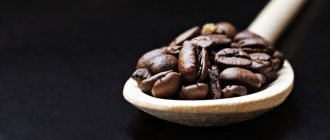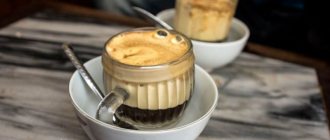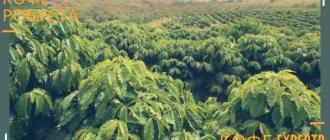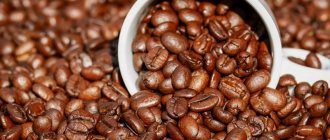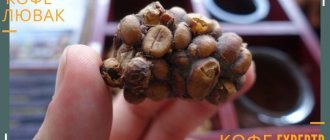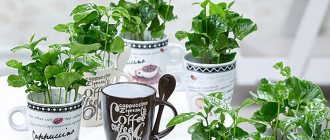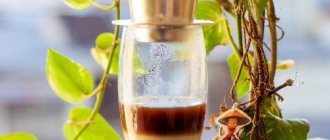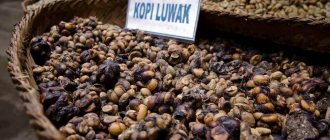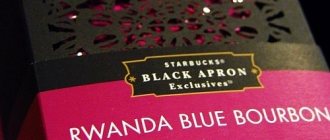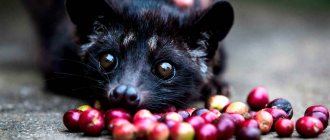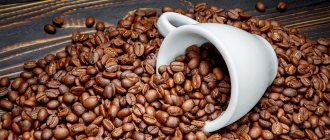Brazil, Ethiopia, Colombia - these popular coffee-producing countries are always on the lips. But you rarely hear that coffee products come from Vietnam. But this is the second exporter of coffee in the world with a profit from the sale of Vietnamese Arabica coffee of at least $1 billion per year and the leader in the sale of Robusta! There is even an opinion that this is almost the only nation capable of creating a single flavor bouquet. Whether this is true or not remains a mystery to this day. However, about 80 countries continue to steadily purchase Vietnamese-made products every year.
Arabica coffee from Vietnam - history and development
For centuries, it has been a well-known fact that the birthplace of coffee is Ethiopia. It was there that they first learned about the miraculous properties of coffee beans, and then introduced them to the whole world. If Yemen and neighboring countries were the first to share the joy of gastronomic discovery with Ethiopia, then the first coffee bushes were brought to Vietnam by French missionaries only in the 19th century. Grown initially in the courtyards of churches, after a short time (from 1865 to 1876), they “captured” an area of 600,000 hectares.
After the end of the Liberation War in the 1970s, the Vietnamese government set its sights on bringing coffee production into the leading sectors of the economy. Coffee plantations, appearing in more and more provinces of the country, began to expand, and when the market became open to foreign partners, the country experienced a real coffee boom. In the 1990s, Vietnam became the second largest coffee seller for the first time.
In 2001, the Asian supplier of coffee products moved to a new stage of development and joined the International Coffee Organization. However, even this could not affect the quality of elite coffee varieties in Vietnam. Today it ranks only 4th in this indicator. The far from perfect growing and harvesting system, unsatisfactory storage conditions for coffee beans and far from ideal transportation are only a small part of the problems of Vietnamese Arabica coffee that prevent it from taking a leading position in the market. There are often cases when elite coffee varieties are mixed with cheaper ones, or even soy is mixed into them.
How is coffee made in Vietnam?
The secret of the high productivity of coffee products in the Asian country lies in the large area of coffee crop cultivation (about 500,000 hectares) and almost year-round harvesting - it begins in October and ends in September of the following year. Most of the plantations are devoted to the cultivation of robusta (85% of all types of coffee in Vietnam). Arabica coffee (24%) and other varieties of coffee account for slightly less production. If the fastidious Arabica is grown in the north and south of the country at an altitude of 500-2500 feet above the sea (at an air temperature of at least 20 ° C), then the less fastidious Robusta thrives in a humid climate at an altitude of 600 meters above sea level.
At the end of the 19th century, the main production of coffee was concentrated in Nghe An province. Afterwards, residents of the Thai Nguyen district began to engage in this profitable business, now producing such a famous variety as Trung Nguyen. Today, the heart of Vietnam's coffee industry is Dak Lak Province. In its administrative center, Buon Ma Thuot, there is a coffee exchange.
Do you want to know who makes coffee in Vietnam and how? The leading role here is given to private farms. The production component is not much different from the technologies of other countries, unless you take into account the production of the elite Luwak coffee variety. Unlike the traditional method of coffee production, where it plays a role how savvy the Vietnamese is in his business, here everything depends on the mood and appetites of the animal - the palm civet.
Previously, this cute creature lived in the Vietnamese forests and, carefreely walking around in freedom, feasted on ripe coffee berries. Enterprising farmers collected their excrement, cleaned, washed and obtained coffee beans with a unique chemical composition. The opportunity to brew them and get an original coffee drink was initially given to the poor.
Today, enterprising businessmen keep these animals in special cages. As soon as their gastrointestinal tract begins to produce a special enzyme (this only happens for 6 months), the animals are fed exclusively with coffee berries. Afterwards, the civet eats regular food - vegetables or fruits. Keeping these animals is not cheap, so entrepreneurs often release civets into the wild for a while. In addition, they do not reproduce in artificially created living conditions.
While Guatemalan coffee has a specific shade of smoky notes, Vietnamese coffee is characterized by a high caffeine content. The fact is that when frying it, a technology different from the standard one is used. Coffee is roasted at lower temperatures in purified vegetable oil with the addition of spices and sweet syrups. What makes Kopi Luwak unique is that it has the typical bitterness of coffee. In search of an answer to the question of how to prepare Vietnamese coffee of this type, coffee lovers often study a lot of specialized literature. However, there are no secrets here - just choose the “Oriental” cooking method.
Vietnamese coffee CHON "Luwak"
by Mrviet
Vietnamese coffee
17.01.2018
Luwak coffee is the most expensive coffee in the world with a unique production technology. The drink has become famous in Indonesia, and is produced mainly on the islands of Java, Sulawesi and Sumatra. The literal translation of the name of this variety means “Luwak coffee.”
Coffee got its name in honor of the animal, thanks to which the Luwak variety appeared. The middle name of this variety is “Kopi Luvak”, and in Vietnamese it is “Chon”. The cost of coffee beans around the world at the moment is from $200 per 1 kg, depending on the purity of the composition. The production of Chon coffee is a unique feature of the Asian country. It is extracted from the natural droppings of the Musang. This little animal eats the most delicious coffee berries. The grains are not digested, but thanks to an enzyme in the digestive tract, they acquire a slight caramel flavor.
There are four ways to obtain the coffee called Luwak.
- The first, and most expensive, is the so-called “wild” Luwak, where everything happens in the natural habitat of the musang, where the animal has the opportunity to choose ripe and tasty berries. Farmers go in search of fresh animal droppings and carefully select coffee beans from them, then roast them and sell them. Of course, this option costs a lot of money, every gram counts, and the price of such coffee exceeds $1000 per kilogram.
- The second method, unfortunately quite common in Vietnam and some Asian countries, is when the musang is put in a cage and fed with pre-collected coffee berries, so the animal often has to eat only coffee berries, the animal’s body is not ready for this and such musangs usually take a long time don't live. Coffee from such farms does not have such a bright taste, because fermentation does not proceed “correctly”. The price of such coffee is from $100 per kilogram.
- The third method is the most common and humane. Having studied the characteristics of the animal’s body, the farms use unique technologies that replicate the taste qualities of real Luwak coffee. Only professionals can distinguish such coffee from the original $1000 drink. The price of such coffee varies from $30 to $70 per kilogram. The price in this case depends on the quality and type of the original grain.
- The fourth way, unfortunately, is an outright lie. If you have been to Vietnam, you have seen coffee called “Luwak” on the market. This coffee is roasted with cheap vanilla flavoring oils, and often a couple of drops of flavoring are dripped near the valve on the coffee package. This gives the impression that the coffee beans are very aromatic, but when you open such a package, it turns out that it contains a poorly selected, low-quality, deep-roasted product, and from an excess of oils there is even a danger of damage to the coffee machine or damage to the coffee maker. The price of such coffee varies from $3 to $20 per kilogram.
Buy Chon Luwak coffee in our online store
Who is Musang?
The musang or Malayan palm civet, also called the Malayan palm civet, is a species of mammal in the family Viverridae, native to South and Southeast Asia. These are small furry animals with thick fur of gray, beige and brown. The average size of musangs is about 50 cm in length. The animals are nocturnal, living mainly in trees, where they sleep during the day - in hollows or intertwining branches. Palm martens are predators that love to feast on the fruits of coffee trees. A large population of animals can cause significant damage to coffee plantations.
How was the technology for producing Kopi Luvak discovered?
Before the emergence of the Luwak coffee variety, the musang population often ate the fruits of coffee plantations. Farmers everywhere were trapping civets to exterminate them. One farmer, feeling sorry for the fruits that “perished” from such raids, came up with the idea of washing the grains that had passed through the animal’s digestive system. The resulting coffee was of interest to gourmets. As a result, coffee, called Luwak, became one of the most expensive varieties in the world.
How is coffee produced?
The high cost of Luwak coffee is due to its unique production technology. The essence of the production is that ripe coffee berries pass through the digestive system of the musang, the Malayan palm civet. Thus, the berries of the coffee tree undergo chemical changes, are fermented by civet, passing through the animal's body. As a result of this process, only the shell of the coffee beans is damaged, and the beans themselves are kept intact. The grains are then removed from the excrement, dried, cleaned and roasted. Thanks to fermentation, the grains cease to taste bitter, and after processing and roasting, they acquire a light chocolate aroma.
The most exclusive are the Luwak coffee beans, which have been processed by the digestive system of musangs in the wild. But getting grain this way is quite problematic.
How much does Luwak coffee cost?
In Vietnam you can find many packages with the image of a palm civet. The cost of these packs of coffee starts from $3. But the low price only means that there are no real Chon beans in the package. Under the guise of Luwak coffee, you can often find artificially fermented coffee, which, thanks to the efforts of farmers, has a similar taste to real expensive coffee.
In Russia, Luwak coffee can be found in specialized stores or online stores; its price reaches 25 thousand rubles per 1 kg.
In European countries, the price for a cup of Kopi Luvak can reach $100. And in Asia, on farms, you can be treated to a cup of this coffee for only 10-20 dollars, but you will never be able to find out what kind of coffee they actually brewed for you.
How to make Luwak coffee
In Europe, Chon coffee is often prepared in a Turkish pot over fire or sand; this cooking option is called oriental. The downside of making coffee in a Turk is that the drink will be bitter.
In Asia, coffee is prepared using a special device - a metal press filter, consisting of three parts: a housing with a filter, a press and a lid. At home, this device is called “fin”. Asian recipes are aimed at maximizing the full flavor of coffee. It is also recommended to use only coarse or medium grind coffee to avoid small particles getting into the finished drink.
Recipe for classic Vietnamese black coffee:
To prepare the drink, place a “fin” on top of a thick-walled glass. Pour 2-3 tablespoons of medium or coarse Kopi Luvak into the filter. Press the coffee into the bottom of the filter. Pour 10 ml of hot water into the filter and leave for 1 minute. When the water has passed, fill the entire filter with boiling water, cover with a lid and let the coffee drip. As soon as the filter passes all the water through it, the drink is ready. To get hot coffee, you can place the glass in a container of hot water while filtering.
You can add sugar, condensed milk, ice to the finished drink, but it is better to drink it in its pure form to feel the full spectrum of coffee taste.
How to store Luwak coffee
In order to preserve “Kopi Luvak” for a long time, you must follow some rules:
- Give preference to foil-based packaging, as well as ceramic or glass containers with an airtight lid.
- Keep grains away from direct sunlight and temperature changes.
Good to know
Types of coffee in Vietnam and their prices
Each country is unique in that it has its own culture, traditions and rituals. So, if in Russia white is a symbol of peace and freedom, then in India it is the personification of death, grief for the deceased and awareness of the possibility of his rebirth. A somewhat similar situation applies to issues of taste preferences in coffee. When visiting Vietnam, you are invited to drink “Cà phê đá” - the best Vietnamese iced coffee. Served in large glass glasses with a straw, the original drink will surprise you with its non-standard form of serving for Russians. However, not everyone decides to try such an exclusive. Watching the Vietnamese crush ice on the asphalt completely discourages any desire to drink anything.
Special mention should be made of “cà phê sữa” or “cà phê nâu” – coffee with milk (white coffee). It must be prepared with the addition of condensed milk. Moreover, unlike the usual technology for preparing the drink, when all the spices and additional ingredients are added to the coffee afterward, the recipe for brewing “cà phê sữa” involves the reverse order - first, condensed milk is poured into a heat-resistant glass, then coffee is poured into it.
Well, the highlight of Vietnamese coffee beans is “cà phê giảng” - coffee with egg. Served either hot or cold, it is never stirred. The ritual of tasting such a drink is that the visitor first eats a beaten egg with a spoon, and only then can drink the coffee itself.
The cost of a Vietnamese exclusive ranges from 8 to 80,000 dong (local currency). For 8,000 dong you can buy an ordinary drink, as we understand it, somewhere in the nooks and crannies of this wonderful country. In a small eatery, the same coffee will be priced at 10,000 dong. Those who like to sit in a cafe will pay 12 – 15,000 dong for coffee from Vietnam. At the same time, the cost of “cà phê sữa” will increase from 15,000 dong, and the price of “cà phê giảng” will be at least 20,000 dong. Ground coffee with filters can be purchased for 50 – 80,000 VND. The best way to do this is in the Dalat region. Surrounded on all sides by coffee plantations, it is considered one of those places where the prices for coffee and tea are the lowest.
Vietnamese coffee
There are several cooking methods – exactly the way the Vietnamese love it. The first is coffee with milk. Or rather, condensed milk with coffee. In Vietnam, it is customary to pour coffee into cups rather than cups. So, first, condensed milk is poured into it, and coffee is carefully poured on top. About the same amount as condensed milk, but very strong. Coffee and milk do not mix. The condensed milk should dissolve in it.
At your request, the seller can add ice there - up to the edge of the glass. It turns out to be the drink of the gods. At 6 o'clock in the morning you can see here and there small plastic tables where Vietnamese people are already sitting and enjoying their morning cup of coffee. Sellers prepare it in advance, pour it into bottles and put it in the refrigerator.
Vietnamese coffee
You can simply ask for “no sugar, no milk,” that is, without sugar and milk.
Do you want it hot, or do you want it with ice? You will not just be served a hot drink, but in a special “dropper”. This is a small metal mug with many holes in the bottom. Ground grains are poured into it, the whole thing is pressed with a press and poured with boiling water. While the drink seeps through the bottom of the “dropper”, it acquires a rich taste and strength. It is not customary to brew coffee in Vietnam. This is the only way to brew it. Almost everywhere they serve iced green Vietnamese tea with coffee. You can use it to dilute your coffee if it is too strong for you. The Vietnamese never drink their coffee to the bottom. There should be enough left in the glass for a couple of sips.
In the north, the Vietnamese love coffee with eggs. In Hanoi, it is served as follows: if you ordered hot coffee, they will bring you a glass in a bowl of hot water, and a separate cup with a raw egg, beaten until creamy. You can also order iced coffee, then it is served with ice.
Many people try to avoid drinks with ice in Asia. This, of course, is a personal matter for everyone, but so far none of the Russians or other foreigners have been poisoned by it or had stomach problems. And to be here and not drink iced coffee is a big omission.
Which Vietnamese coffee beans is best?
There is no consensus on this issue. Some praise the Me Trang, Duong Phuong and Vietnam Trung Nguyen coffee varieties, others consider Che Phin 4 the best of the best - a unique mix of all known varieties of coffee: Arabica, Catimor, Robusta, Excelsa. Be that as it may, the popular Four Seasons coffee shop in Vietnam will help you get rid of doubts. Acting as both a place for tasting coffee varieties and an official point of sale, it will allow you to put everything in its place and buy what you specifically liked.
For example, you can buy the following types of Vietnamese coffee:
- Arabica is a soft, balanced coffee with a refined sour taste. Differs in the complexity of cultivation and caffeine content of 1.5%.
- Arabica SE is a unique variety of coffee beans found only in Vietnam. Recognizable by its distinct balance of aroma and multi-faceted taste, it is considered one of the most exquisite products in the world of coffee.
- Catimor is the result of crossing Cattura and Hibrido de Timor. Characterized by high resistance to disease, it gives connoisseurs of this delicious drink the opportunity to experience an original, fruity aftertaste.
- Robusta is the most affordable type of coffee bean with a caffeine percentage of 2.6%. Giving the drink strength, thickness, high foam and a dark shade of infusion, it especially finds recognition among strong, self-confident men.
Which coffee is the best in Vietnam remains for each coffee lover to decide individually. One thing is for sure - in order to find your ideal, you need to personally brew, compare and evaluate each of them.
Signature roast
A distinctive feature of Vietnamese coffee is the roasting of the beans. It can occur in different ways with the addition of various components, however, its main indicator is basic for all methods.
A characteristic feature of this region is the slightly chocolate aftertaste of the drinks. This is achieved by roasting coffee beans with cocoa beans.
Also, when roasting, different manufacturers may add:
- fruit syrups;
- Coconut oil;
- sugar;
- walnut oil;
- diluted condensed milk;
- powdered milk.
Degrees of doneness can also vary from low to high.
Classic Vietnamese coffee is made from highly roasted Robusta and Arabica beans with the addition of coconut oil and cocoa beans.
What are the best high-end coffees in Vietnam?
According to the widespread opinion of the world's captesters, it is not what matters, but how to cook. Undoubtedly, the opportunity to evaluate the elite of Vietnamese coffee beans fuels some special expectations in the taster. And this, of course, is not just like that!
- Arabica Culi or Robusta Culi are elite varieties of famous types of coffee, which are characterized by an interesting aroma and taste and a higher price.
- Excelsa or Shari is a type of coffee tree with an unpredictable character. Incredibly susceptible to climate change, it can often leave farmers without income for several seasons. The use of Excel as a monosort is not so common. However, if you want to learn how to brew Vietnamese coffee, it can be consumed as part of a sophisticated blend.
- Chon, Kopi Luwak or Weasel are the most expensive varieties in the world. Known for their method of producing coffee beans using animals, they are characterized by limited production volumes.
Each of the presented varieties of Vietnamese coffee is the pride of the coffee collection of its copyright holder. And if you have been honored to experience all the richness of the palette of their aroma and taste, then you can rightfully be called a “coffee aesthete”! Due to the high cost of the products presented above, such a chance sometimes occurs once in a million.
Cooking options
There are several ways to brew Vietnamese coffee. In addition to the classic version, other recipes for preparing an invigorating drink at home are also popular in the country.
Brewing in Fin
Making coffee using this method is quite simple. Thanks to the use of fin, it is possible to fully reveal the aroma. The preparation procedure boils down to the following steps:
- The press filter is doused with boiling water.
- Add a spoonful of ground grains.
- Pour literally 20 ml of boiling water.
- A press is placed on top.
- Add a spoonful of crushed grains again.
- Fill the filter completely with boiling water.
- Wait until all the liquid has seeped into the bowl.
White coffee
The peculiarity of this recipe is the addition of condensed milk and an unusual technology for combining the components. Follow the following sequence of actions:
- Place a couple of spoons of condensed milk on the bottom of the bowl.
- A filter is placed on top and ground grains are laid out.
- Press them with a press and pour boiling water over them.
- When the water has completely seeped through, the distinction between the coffee top and the milky bottom becomes clearly visible. All that remains is to mix the ingredients and add ice cubes.
Vietnamese coffee occupies a significant position in the global coffee market. Several varieties of grains are grown in the country. Each of them has a number of distinctive features. Having understood them, you will be able to choose the most suitable option.
How to brew/brew coffee in Vietnam - general rules
To prepare Vietnamese coffee, you need to take a Turk or coffee pot, grind the beans and... But no! In Vietnam, when planning to prepare a flavorful drink, they will never use these coffee gadgets, because it will taste bitter. An alternative device for brewing coffee is an aluminum filter with a press (fin), the cost of which does not exceed 23 - 27,000 dong.
How is coffee brewed in Vietnam using the presented method? This action happens like this:
- A filter is placed on the cook's coffee cup.
- Approximately 3 teaspoons of freshly ground coffee are poured into it.
- The contents of the filter are pressed with a press and boiling water is poured onto it.
- The drink is infused for 4 - 5 minutes, and then diluted with condensed milk or “seasoned” with ice, it is served.
However, this method of preparing Vietnamese coffee (which can only be learned better by comparison) requires time and money. In Vietnam, you can save on your love for an invigorating drink by going to the store and buying the so-called “Càphê Tươi” - fresh coffee. Bottled to hold twelve 40 ml cups of the drink, it costs only 34,000 VND. At the same time, the savings of a far-sighted coffee lover can be up to 110,000 VND.
How to brew and prepare the best Vietnamese coffee - recipe
Being the second largest coffee exporting country in the world, Vietnam undoubtedly has its own traditions of preparing and drinking the aromatic drink. If, for example, in Finland, before drinking coffee, a piece of cheese is placed in a cup, and in Morocco, sesame, black pepper and nutmeg are mixed into the drink, then Vietnamese coffee is famous for its close connection with condensed milk. For those who have long wanted to know how coffee is brewed in Vietnam, we decided to post this recipe here:
- Prepare everything you need for brewing coffee - fin, a heat-resistant glass glass, water (boiling water), condensed milk, 2 teaspoons of freshly ground Vietnam Thai Nguyen coffee or some other type.
- Pour condensed milk into a glass in a 1:1 ratio
- Place the assembled filter, necessary for brewing high-quality coffee, on the glass.
- Pour 1 teaspoon of coffee powder inside.
- Gently level the coffee grounds using the tamping lid.
- Pour a little boiling water into the glass and turn the tamping lid clockwise to better distribute the coffee powder at the bottom of the glass vessel.
- Add the remaining volume of boiling water and close the structure with a lid.
- Prepare coffee in this way for 15 minutes.
- After the time has elapsed, carefully stir the contents of the glass glass.
It's time to taste the original and unique coffee from Vietnam! The Tastybar online store is always happy to present the freshest and highest quality raw materials for its preparation.
